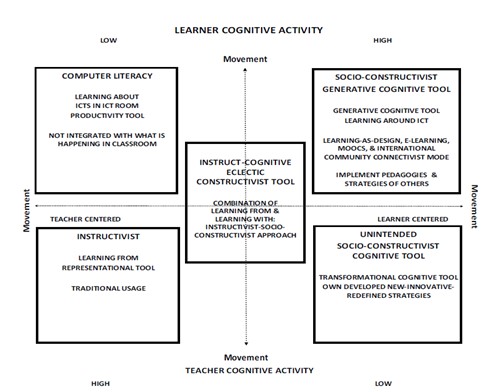Our ICT related Mathematics and Science subject interventions are an attempt to promote the socio-constructivist generative tool usage as presented in Figure 1. For that reason, we posit that pedagogy is underpinned by:
-
social constructivism (Vygotsky, 1978),
-
constructionism (Papert & Harel, 1992; Kafai, Ching & Marshall, 1997; Kynigos, 2015),
-
learning as design (Perkins, 1986; Kafai, Ching & Marshall, 1997),
-
project-based learning elements (Kokotsaki, Menzies & Wiggins, 2016; Kraus & Boss, 2013).

Figure 1: ICT implementation matrix (Du Plessis, 2016)
The mentioned theories hold promise to:
-
promote motivation and interest,
-
encourage greater self-efficacy as well as development of the critical outcomes of the Curriculum Assessment Policy Statement (CAPS), and
-
improve results related to curriculum related knowledge and skill aspects in comparison to learners not exposed to our intended intervention.
The implementation of the proposed interventions affords opportunities for:
-
cognitive growth,
-
greater interest and motivation,
-
greater satisfaction towards learning,
-
greater self-efficacy,
-
an improvement related to the development of the critical outcomes; and
-
better results in science and mathematics content facilitated by our approach.
Table 1 presents a holistic overview of possible interventions, their theoretical grounding, research focus and phases.
Table 1: Mixed method research
|
Intervention
|
Theoretical grounding
|
Possible research focus
|
Phases
|
|
Tanks coding
|
-
Social constructivism
-
Motivation theory
-
Self-efficacy theory
-
Game theory
|
-
Motivation and interest
-
Self-efficacy
-
Thinking skills
-
Critical outcomes
-
Influence on Mathematics learning
|
Mixed Method Research: Pragmatic paradigm
-
Phase 1: Pre-testing of controlled and experimental groups
-
Phase 1: Open-ended questionnaire
-
Phase 2: Intervention of between 4 to 12 weeks [Teachers to be part of project]
-
Phase 3: Post-testing of controlled and experimental groups
-
Phase 3: Open-ended questionnaire
-
Phase 4: Teachers implement similar project
-
Phase 5: Drawings as data prompting tool with individual teachers
-
Phase 6: Focus group interviews with teachers
-
Phase 7: Joint evaluation by teachers and researchers
|
|
Droning
|
-
Social constructivism
-
Self-efficacy theory
-
Game theory
|
-
Motivation and interest
-
Thinking skills
-
Critical outcomes
-
Influence on Mathematics learning
|
|
Artefact creation
|
-
Social constructivism
-
Constructionism
-
Self-efficacy theory
|
-
Motivation and interest
-
Thinking skills
-
Critical outcomes
-
Influence on Mathematics learning
|
|
YouTube videos for learning
|
-
Self-regulated learning
-
Self-efficacy theory
-
Satisfaction related theory
-
Diffusion of innovation theory
-
UTAUT theory
|
-
Motivation and interest
-
Thinking skills
-
Critical outcomes
-
Influence on Mathematics learning
|
|
Science notebook for writing science
|
-
Scientific literacy
-
Social constructivism: Types of talk (cumulative, disputational and exploratory talk)
-
Self-efficacy theory
-
Diffusion of innovation theory
-
UTAUT theory
|
-
Motivation and interest
-
Thinking skills
-
Critical outcomes
-
Influence on Mathematics learning
|
Table 2 focuses on the qualitative dimension of the intended research
Table 2: Qualitative research
|
Intervention
|
Theoretical grounding
|
Possible research focus
|
Phases
|
|
Tanks coding
|
-
Social constructivism
-
Motivation theory
-
Self-efficacy theory
-
Game theory
|
-
Motivation and interest
-
Self-efficacy
-
Thinking skills
-
Critical outcomes
-
Influence on Mathematics learning
|
Qualitative Research: Interpretivist and Critical paradigm
-
Phase 1: Open-ended questionnaire on science or mathematics learning experiences
-
Phase 1: Individual or Focus group interviews on science or mathematics learning experiences
-
Phase 2: Intervention
-
Phase 3: Open-ended questionnaire on science or mathematics learning experiences
-
Phase 3: Individual or Focus group interviews on science or mathematics learning experiences
|
|
Droning
|
-
Social constructivism
-
Self-efficacy theory
-
Game theory
|
-
Motivation and interest
-
Thinking skills
-
Critical outcomes
-
Influence on Mathematics learning
|
|
Artefact creation
|
-
Social constructivism
-
Constructionism
-
Self-efficacy theory
|
-
Motivation and interest
-
Thinking skills
-
Critical outcomes
-
Influence on Mathematics learning
|
|
YouTube videos for learning
|
-
Self-regulated learning
-
Self-efficacy theory
-
Satisfaction related theory
-
Diffusion of innovation theory
-
UTAUT theory
|
-
Motivation and interest
-
Thinking skills
-
Critical outcomes
-
Influence on Mathematics learning
|
|
Science notebook for writing science
|
-
Scientific literacy
-
Social constructivism: Types of talk (cumulative, disputational and exploratory talk)
-
Self-efficacy theory
-
Diffusion of innovation theory
-
UTAUT theory
|
-
Motivation and interest
-
Thinking skills
-
Critical outcomes
-
Influence on Mathematics learning
|
Our intervention has as its aim to enable teachers to utilise the pedagogy that we intend to model. In order to achieve possible adoption of our innovations, we will be embracing Rogers’ (2003) diffusion of innovation perspective through his perceived attributes theory which postulates that the following aspects have to be planned for when presenting the innovation, namely simplicity, trialability, observability, relative advantage and compatibility. Another vital aspect is that of support (Wilson, Sherry, Dobrovolny, Batty & Ryder, 2001) which then results in the acronym, STORCS. Linked to these attributes, is the innovation-decision process theory which highlights knowledge, persuasion, decision making to adopt or to reject, implementation and possible reinvention, and confirmation or rejection (Rogers, 2003).